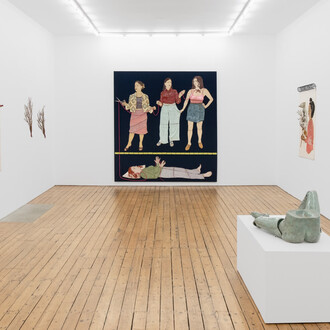The Approach is excited to present Die Wässer und Libellenlust, a solo exhibition of works by Heidi Bucher. The show focusses on water and the symbol of the dragonfly, two major aspects of her practice that resonated throughout the late ‘70s and ‘80s. These elements highlighted Bucher’s fascination with the processes of shedding, transformation and renewal. Bucher’s employment of water, with its ablutionary qualities, and the dragonfly, which, as an embodiment of metamorphosis, represented her vision of breaking free from the constraints and traumas that haunt both one’s past and present.
Although Bucher is widely known for the architectural aspects of her practice, water, due to its innately transient nature, was also a central theme for the artist. A major piece featured in this exhibition is Wassertor, which, based on scale alone, demonstrates the extent of Bucher’s fascination with water. Unlike Bucher’s well known ‘caoutchouc’ skinnings of interiors, the Wassertor piece has not been cast, but instead is a completely imagined work. Appearing almost as a waterfall, the piece shimmers iridescently, showing off the mother-of-pearl pigments Bucher has brushed across the entire surface of the work. Directly translated as ‘water gate’, Wassertor takes on the role of an enchanted object, acting as a kind of threshold or portal, suggesting that if one were to try and walk through it, they would be cleansed and renewed.
The water theme is continued in the works on paper, where Bucher has created gestural and expressive watercolour paintings of waves, ripples and splashes. The bright blue paintings evoke the constant movement and vivacity of water, these particular qualities were important for Bucher, who believed in the necessity for transformation and reincarnation. Bucher also saw water as representative of femininity, considering the use of water in her work as being symbolic of the amniotic fluid of a womb.
The Libellen (dragonfly) was a significant symbol in Bucher’s practice between 1976 – 1983. For Bucher, the dragonfly not only represented the delicate and tender beauty that can be found in the world, but, both physically and metaphysically, the dragonfly embodied the act of transformation and renewal, through its life process of shedding skin and becoming reborn:
The dragonfly as a light, iridescent, enchanting creature that is associated with water and seems to hover above all worlds, fascinated Bucher. Freud equated the dragonfly with the need for freedom, but also with the idea that freedom can only be short-lived. The dragonfly is regarded as a symbol for excessive egocentricity and indicates that the person dreaming is too easily taken in by outward appearances. But the dragonfly is also a symbol of inspiring imaginative power; it represents the beauty of the spirit and, above all, immortality through the capacity for renewal.
Bucher invented the term ‘libellenlust’. Directly translated as ‘dragonfly joy’, this translation does not quite convey the expressiveness of the term, which, for the artist, was not only about finding joy in dragonflies, but also encapsulated the joy in experiencing, as a dragonfly, the lightness, freedom and delight of drifting frivolously across a pool of water.
The film Bodyshells, 1972, will be screened in The Annexe. The 16 mm video shows the entire Bucher family (Heidi, with her husband at the time, Carl Bucher, and their two children, Mayo and Indigo) walking across Venice Beach in LA, wearing soft, iridescent body suits made from foam and brushed with dustings of mother-of-pearl. Large and rotund, the costumes mimicked the shapes and bodies of creatures one might find on the seashore, but in particular molluscs and shellfish, whose delicate invertebrate bodies keep themselves safe within protective nacreous shells. The Bodyshell suits are human-sized portable homes for the wearers, cocoons which further exemplify Bucher’s concern with the house as a shell, a place of safety, as well as a container for memory and trauma.
















